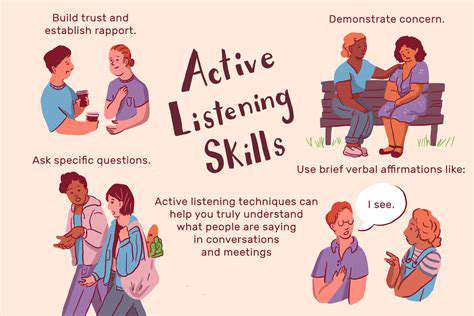Guide to Content Marketing for Small Businesses

Promoting Your Content to Reach a Wider Audience
Understanding Your Target Audience
To effectively promote your content, you need a deep understanding of who you're trying to reach. This involves more than just knowing their demographics. Consider their interests, pain points, online behavior, and preferred platforms. Analyzing their existing online presence, identifying their challenges, and understanding their motivations will help you craft content that truly resonates with them and positions your business as a valuable resource.
Knowing your target audience allows you to tailor your content to their specific needs and preferences, leading to increased engagement and conversions. A deep dive into their online habits, like which social media platforms they frequent, the types of content they consume, and the keywords they use in their searches, is crucial for crafting a successful content marketing strategy.
Crafting Compelling Content
High-quality content is the cornerstone of any successful content marketing strategy. It needs to be informative, engaging, and provide real value to your target audience. This means going beyond simply promoting your products or services; instead, focus on providing insightful information, addressing their needs, and offering solutions to their problems.
Remember, your content should be optimized for both search engines and human readers. Use relevant keywords, write in a clear and concise style, and ensure your content is well-structured and easy to navigate. Engaging visuals, such as images and videos, can also significantly boost the appeal and effectiveness of your content.
Utilizing SEO Strategies
Search Engine Optimization (SEO) is crucial for ensuring your content is discoverable by your target audience. Optimizing your content with relevant keywords, creating compelling meta descriptions, and building high-quality backlinks can dramatically improve your search engine rankings.
Understanding how search engines work and how users search for information is key to effective SEO. Conduct thorough keyword research to identify the terms your target audience is using. Incorporate these keywords naturally into your content, titles, and descriptions to enhance visibility.
Leveraging Social Media Platforms
Social media platforms are powerful tools for reaching a wider audience. Identify the platforms where your target audience is most active and tailor your content accordingly. Share engaging content, interact with followers, and participate in relevant conversations. Using social media ads and targeted campaigns can further expand your reach and drive traffic to your content.
Building Relationships with Influencers
Collaborating with influencers can significantly amplify your content's reach and credibility. Identify influencers whose audience aligns with your target demographic and whose values resonate with your brand. Engage in meaningful collaborations that benefit both parties, such as guest posts, sponsored content, or joint promotions.
Email Marketing for Targeted Outreach
Email marketing remains a highly effective way to nurture leads and keep your audience engaged with your content. Build an email list by offering valuable incentives, such as exclusive content or discounts. Craft compelling email newsletters that deliver consistent value to subscribers. Segment your email list based on audience interests and behavior to personalize your communication.
Analyzing Performance and Adapting Strategies
Regularly monitoring the performance of your content marketing efforts is essential for identifying what's working and what needs improvement. Track key metrics like website traffic, engagement rates, conversion rates, and social media interactions. Analyze the data to understand what resonates with your audience and adjust your strategies accordingly. Iterative improvement based on data analysis is key to sustained growth.
Measuring and Analyzing Your Results
Defining Key Performance Indicators (KPIs)
A crucial first step in measuring and analyzing your content marketing results is defining specific, measurable, achievable, relevant, and time-bound (SMART) KPIs. These KPIs should align directly with your overall business objectives. For example, if your goal is to generate leads, your KPIs might include website traffic from specific content pieces, conversion rates from landing pages, and the number of qualified leads generated through your content. Understanding what you're trying to measure from the outset will provide a clear framework for your analysis.
Choosing the right KPIs is vital for accurately assessing the success of your content marketing efforts. Don't get bogged down in vanity metrics; instead, focus on metrics that directly impact your bottom line, such as lead generation, customer acquisition cost, and sales conversions. By focusing on these specific metrics, you can gain valuable insights into what's working and what needs improvement.
Tracking Website Traffic and Engagement
Monitoring website traffic and user engagement is essential for understanding how your content is performing. Tools like Google Analytics provide valuable data on page views, time on page, bounce rate, and unique visitors. Analyzing this data can reveal which content pieces are resonating with your audience and which ones might need a refresh or a complete overhaul.
Analyzing Content Performance
Digging deeper into your content performance is critical for identifying trends and patterns. Consider which content pieces are driving the most traffic, engagement, and conversions. This analysis can help you optimize your content strategy, focusing on topics and formats that resonate most strongly with your target audience.
Evaluating Lead Generation and Conversion Rates
One of the primary goals of content marketing is to generate leads and drive conversions. Tracking the number of leads generated from different pieces of content and analyzing conversion rates from landing pages are key metrics to monitor. This analysis can help you identify which content formats and topics are most effective at attracting and converting potential customers.
Assessing Customer Engagement and Feedback
Analyzing customer engagement with your content is important for understanding their needs and preferences. Look at comments, shares, and social media interactions to gauge audience reception. Actively soliciting customer feedback through surveys and feedback forms can provide valuable insights into how you can improve your content and better serve your target audience.
Measuring ROI and Return on Investment
Ultimately, you want to measure the return on investment (ROI) of your content marketing efforts. This involves connecting your content performance to tangible business outcomes, such as increased sales, higher customer lifetime value, and cost savings. By linking your content strategy directly to quantifiable business results, you demonstrate the value of your content marketing initiatives.
Adapting and Optimizing Your Strategy
Content marketing is an iterative process. Regularly analyzing your results, identifying trends, and adapting your strategy accordingly is crucial for achieving optimal performance. This includes experimenting with different content formats, topics, and distribution channels. By continuously monitoring and adjusting your approach, you can ensure that your content marketing efforts remain effective and aligned with your business objectives.
Read more about Guide to Content Marketing for Small Businesses
Hot Recommendations
- How to Stay Productive While Working Remotely
- Tips for Managing Conflict with Coworkers
- Entrance & Certification Exams (升学考试)
- How to Improve Your Storytelling Skills (Speaking)
- How to Find Profitable Side Hustles
- Tips for Preparing for the TOEFL iBT Home Edition
- Guide to Switching Careers from [Industry A] to [Industry B]
- How to Run an Effective Hybrid Meeting
- Tips for Marketing Your Side Hustle on Instagram


![Guide to Learning [Specific Writing Style, e.g., Technical Writing]](/static/images/32/2025-05/UtilizingEffectiveLearningTechniques.jpg)







